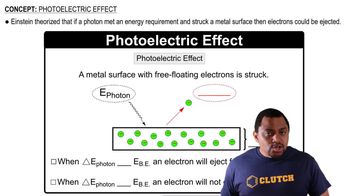Here are the essential concepts you must grasp in order to answer the question correctly.
Photoelectric Effect
The photoelectric effect is the phenomenon where electrons are emitted from a material when it absorbs light of sufficient energy. This energy is determined by the wavelength of the light, with shorter wavelengths corresponding to higher energy photons. The work function is the minimum energy required to eject an electron from the surface of a material, and if the incoming light's energy exceeds this threshold, electrons will be emitted.
Recommended video:
Wavelength and Energy Relationship
The energy of a photon is inversely related to its wavelength, described by the equation E = hc/λ, where E is energy, h is Planck's constant, c is the speed of light, and λ is the wavelength. Thus, shorter wavelengths (like 400 nm) have higher energy than longer wavelengths (like 450 nm). This relationship is crucial for determining whether a photon can eject electrons from a given material based on its work function.
Recommended video:
Frequency-Wavelength Relationship
Amplitude of Light Waves
The amplitude of a light wave relates to its intensity, which affects the number of photons present but not their energy. In the context of the photoelectric effect, while higher amplitude light can increase the number of photons hitting the surface, it does not change the energy of individual photons. Therefore, to maximize electron ejection, the wavelength must be appropriate to exceed the work function, regardless of amplitude.
Recommended video:



